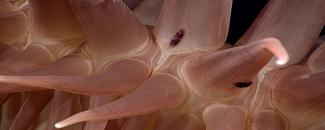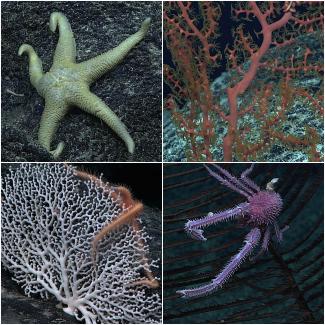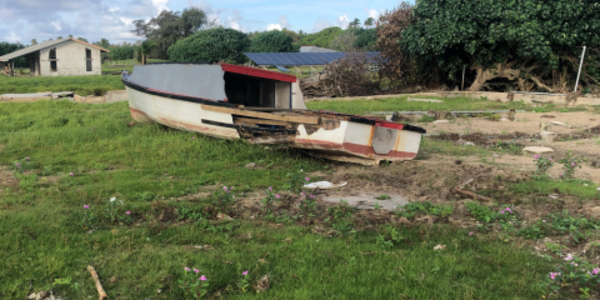
To most of us, the bottom of the ocean is as mysterious and enigmatic as deep space. When we do get a glimpse into this secret world, it can be a bit frightening. Creatures that resemble Hollywood monsters often come to mind. But amongst the formidable also lies the beautiful, the unique, and the curious. For every lurking cusk-eel, there’s an adorably plump synallactidae sea cucumber.
The bottom of bodies of water, such as the ocean, is teeming with life known as “benthos.” These aquatic creatures live on, in, or near the bottom of water bodies. So, whether you’re sailing on the open ocean or kayaking around the lake down the road, you’re floating above an underwater universe made up of benthos!
Browsing Benthos
They may have started at the bottom, but now they’re here in NOAA’s Benthic Deepwater Animal Identification Guide. Images collected by NOAA Ocean Exploration’s 2015–17 Campaign to Address Pacific Monument Science, Technology, and Ocean Needs (CAPSTONE) provide a virtual treasure chest of benthic animals. From Annelids to Zoantharians, the Benthic Identification Guide gives you a glimpse into the often unseen world of deep-sea creatures.
There are over 5,000 high-resolution images of marine animals created from video recorded during the NOAA Ship Okeanos Explorer’s missions in the Pacific Ocean in 2015, 2016, and 2017. But, these photographs are more than just pretty pictures—they assist with scientific discovery and classification.
The Benthic Deepwater Animal Identification Guide was created by NCEI, with the guidance of Dr. Christopher Kelley of the University of Hawaii. The Guide was also developed with the assistance of an array of taxonomic experts from research institutes, universities, and government agencies worldwide.
The guide is organized by major taxa, or scientific units of animals. The guide assists in scientific discovery and classification, serving as a resource used by scientists around the world to further classify or even identify benthic animals. Having a worldwide network of scientists lending their knowledge of benthic creatures ensures that the images and data collected are identified and classified accurately.
Science Goes Deep
Some benthic animals reside as deep in the ocean as 5000 to 6000 meters. That’s the equivalent of thirteen Empire State Buildings stacked on top of each other. So how do we learn more about these creatures when they seem inaccessible to humans?
While an actual scientist may not be able to dive to these depths in person, a remotely operated vehicle (ROV) certainly can. NOAA Ship Okeanos Explorer, explores our largely unknown ocean for the purpose of discovering and learning more about sea life, such as benthic animals. The Okeanos Explorer is home to the Deep Discoverer ROV, which can dive to depths of nearly four miles and withstand pressures almost 600 times that at sea level. This ROV provides scientists with high-quality imagery and environmental data that give valuable insights into complex underwater ecosystems.
ROV imagery and data have enabled scientists to identify previously unknown animals. Many new species or genus (a group of species that are closely related) were discovered during the exeditions, including a seastar, red coral, and white coral. The white coral was named Crypthelia kelleyi. Likewise, the adorably prickly squat lobster is a new genera of the family Chirostylidae.
Scientists collected over thirteen specimens of deep-water coral during the campaign. A Smithsonian scientist who specializes in these and other families of coral determined that nine of these specimens are new in some form; eight being a new species and one being a new genus.
While all of these Latin scientific names may not mean much to the average person, they symbolize important advances in scientific discovery and the future of deep-ocean exploration.
What are Benthos?
Most benthos are spineless bottom feeders. That may sound harsh, but many benthos are indeed invertebrates, meaning they lack a backbone. Creatures like sea stars are a great example of an invertebrate benthic species. With about 2,000 species of sea stars living in the ocean, these charismatic critters are widely known for having five arms, but species with ten, twenty, and even forty arms exist.
Though benthos feeding habits differ, many filter feed, which entails sieving food particles or small organisms from the ocean. Others eat bottom sediments, graze on kelp, eat carrion, or hunt other animals. Because sunlight cannot usually reach below 200 feet in the ocean, few food sources grow on the deep seafloor. Therefore, benthic animals in the deep ocean have to rely primarily on food particles that migrate down from higher up in the ocean. A good portion of this “food rain” is eaten by animals higher up, leaving the deep-sea benthic creatures with what little remains.
The diversity of life is much higher at the bottom of water bodies than the top primarily because the bottom offers many more types of habitats that organisms can adapt to. Research indicates that the diversity of species living in the deep sea may rival the richness of species found in tropical coral reefs.
While it’s natural to assume that few lifeforms could withstand the harsh, frigid habitat of the deep ocean, benthic organisms are well adapted to this environment, living and thriving in the cold, dark waters. These animals adapt by having low metabolic rates, living and working at a slower speed than organisms in warmer waters. For example, some species of squat lobsters, such as Munidopsidae (a member of the Galatheoidea family), live at depths of 1000–5000 meters (.62–3.1 miles) in the ocean. They can be found in seamounts, canyons, and next to deep-sea hydrothermal vents.
To cope with the vast darkness, many benthic creatures create their own light. Bioluminescence, a colorful, chemical glow that can be turned on and off, serves several purposes. Many species of benthos flash colors and patterns to communicate with their own kind. Hunters use bioluminescence to search out prey, and the hunted use this light to ward off or confuse predators. Other creatures, unable to create their own light, borrow it from those who can. Known as fluorescence, they absorb the light from other organisms and reemit it as a different color.
As water depth increases, so does water pressure. Over most of the deep seafloor, benthic animals must withstand thousands of pounds of water pressure across their entire bodies. These animals avoid the pressure by filling their tissues and internal cavities with water instead of gas.
Global Impact
Benthic animals aren’t just resting on their laurels all day—they serve a crucial role in the underwater ecosystem. Fish species such as haddock, catfish, and most flatfishes eat benthos. Many benthic animals sieve the ocean floor and scavenge on dead organisms, essentially cleaning it up. Feeders and active diggers regularly move the bottom sediments, increasing the oxygen content and overall productivity, much like earthworms on land.
Though the deep ocean region benthos call home is remote, its impact is far reaching. Researchers hope that the survival strategies used by deep-sea benthic animals to cope with environmental extremes may one day be adapted to improve human health and life. Scientists already use bioluminescent and fluorescent chemicals found in some benthic animals as genetic markers in medical research. Other enzymes, genes, and compounds that allow animals to function despite crushing pressure and freezing cold are under investigation for use in new medicines, industrial processes, and toxic waste cleanup.




